IBDP Online Test Series By iitianacademy
Comprehensive Test Preparatory package targeted towards IBDP
Question
The picture shows workers cleaning up a polluted stretch of coastline in Alaska after oil was leaked from a tanker.
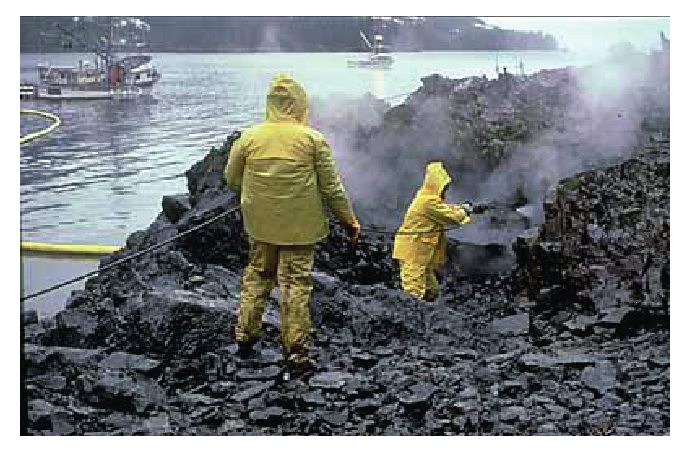
[Source: https://commons.wikimedia.org/wiki/File:OilCleanupAfterValdezSpill.jpg]
Explain how oil pollution can be treated by bioremediation.
Answer/Explanation
Markscheme
a. bioremediation is the use of organisms to remove «or neutralize» pollutants
b. Pseudomonas species used in bioremediation of oil
c. oil biodegrades naturally at a very slow rate
d. bioremediation increases the rate that the oil breaks down
e. microorganisms feed/get energy from the oil
f. break the oil down into smaller nontoxic molecules
Accept other valid microorganism
[Max 4 Marks]
Question
Researchers in Korea set up an experiment to measure how accumulation of biofilm changes in water pipes under different conditions.
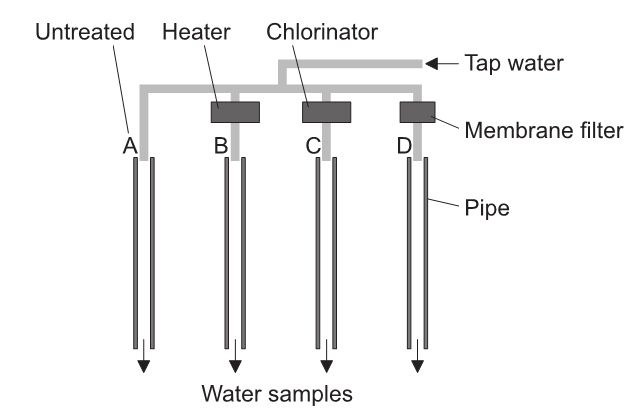
The graph shows the accumulation of biofilm in steel pipes when the water was untreated, treated with chlorine and filtered through a membrane.
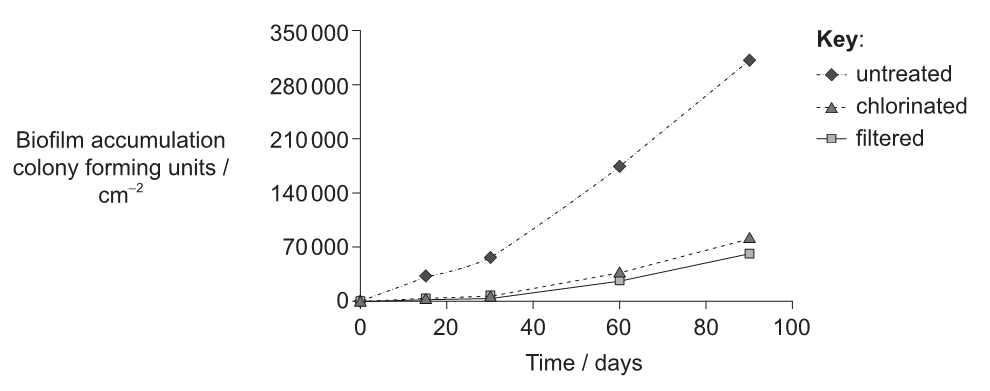
[Source: adapted from Yoonjin Lee, (2013), Journal of Environmental Research Public Health 2013, 10 (9), pages 4143 – 4160]
State the effect chlorination has on the accumulation of biofilm in the pipe.
Suggest why membrane filtration may be more suitable than chlorination in purifying the water.
Identify which two pipes would be required to study the effect of heat on biofilm accumulation.
Explain how quorum sensing benefits the bacteria within the steel pipes.
Answer/Explanation
Markscheme
reduces «the accumulation of biofilm»
a. does not affect taste of water/no chemicals added
b. lower biofilm accumulation over time
[Max 1 Mark]
A and B
Both required
a. quorum sensing is a means of communication between bacteria
b. allows the bacteria to synchronize their activities/work together
c. they can change according to the environment/conditions in the pipe
d. control cell density/gene expression
[Max 2 Marks]
Question
The diagram shows a biofilm that has formed on a tooth.
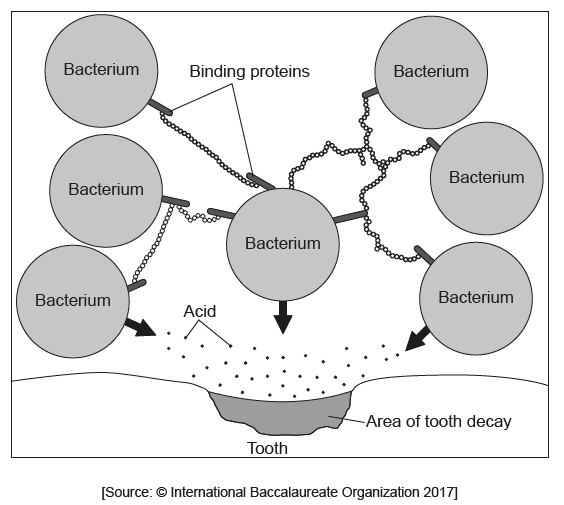
Using the diagram, explain the concept of emergent properties of biofilms.
Answer/Explanation
Markscheme
a. «in biofilms» bacteria exhibit «emergent» properties not predictable from the individual components of the system
OR
biofilm exhibits its own properties, quite different in comparison with those shown by the single species
b. biofilms form when bacteria adhere to surface of tooth and begin to excrete an EPS/extracellular polymeric substances/exopolysaccharides
c. formation of EPS maintains bacteria together «in biofilm»
d. interspecies relationships are favourable
OR
one species produces growth factors for/facilitates attachment of another species
e. individual forces are low but the overall binding force can exceed that of covalent bonds
f. glue properties/cohesiveness given by different types of bonding
g. biofilms show resistance to antibiotics/other pathogen
Question
Explain how microorganisms can be used in response to pollution incidents such as an oil spill.
Answer/Explanation
Markscheme
a. «bioremediation» is the use of microbes to remove environmental contaminants from oil spill
b. some pollutants are metabolized/degraded by microorganisms
c. microorganisms can be eubacteria/archaeans
d. microorganisms are useful in bioremediation because they can multiply very quickly «by binary fission»
e. microorganisms can use pollutants/oil spills/crude oil as energy sources/carbon sources/electron acceptors in cellular respiration
f. eg: Pseudomonas used «in bioremediation»
g. Pseudomonas requires nutrients «such as potassium and urea» to metabolize the oil at a faster rate «so sprayed on to an oil spill to aid the bacteria in their work»
Question
Freshwater invertebrates were sampled by students at three sites along a river in central France. The animals were identified and counted. The diversity of each site can be compared using Simpson’s reciprocal index.
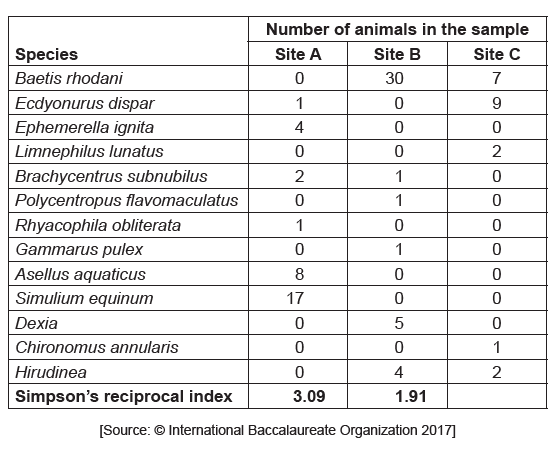
Simpson’s reciprocal index is given by the following formula:

Calculate the diversity of site C. Working should be shown.
Site A has a higher Simpson’s reciprocal index than Site B showing that its diversity is higher.
Explain the reason that ecologists consider Site A to have a higher diversity than Site B, despite both sites having six different species present.
Discuss the advantages and disadvantages of in situ conservation methods.
Answer/Explanation
Markscheme
a. ![]()
b. = 3.56 «allow 3.55»
a. the species in Site A are more evenly represented than site B
b. site B has a large number of one species «but very few in the other 5»
c. Simpson’s reciprocal index is a measure of species evenness as well as species richness
Advantages:
a. conservation in the natural habitat / ecosystem
b. the species will have all the resources that it is adapted to
c. the species will continue to evolve in their environment / can maintain genetic diversity
d. the species have more space so a bigger breeding populations can be kept
e. it is cheaper to keep an organism in its natural habitat
f. established food webs/ species interactions can be maintained
Disadvantages:
g. it is difficult to control illegal exploitation «eg poaching»/harder to monitor populations
h. the area may need restoring / may be required for other purposes
i. alien species are difficult to control
j. species close to extinction are harder to conserve
k. management/protection may represent a significant cost
Question
Benzene is a cancer-causing component of crude oil. Some halophilic bacteria degrade benzene. Using a culture of bacteria obtained from an oil fi eld in the US, degradation of benzene was studied by microbiologists.
The microbiologists cultured the bacteria at different concentrations of sodium chloride (NaCl) and measured the amount of benzene left at different times.
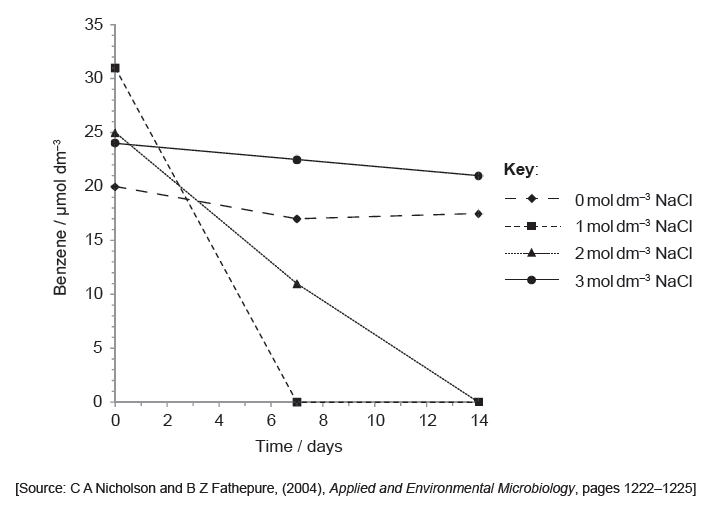
Determine the optimum concentration of sodium chloride for benzene degradation.
State the genus of halophilic bacteria in the soil that could be degrading the benzene.
Answer/Explanation
Markscheme
1 mol dm-3
Marinobacter
Question
Korean microbiologists tested the effect of ginger root (Zingiber officinale) extracts on biofilm formation by the bacterium Pseudomonas aeruginosa. Formation of a biofilm prevents the bacteria from spreading. These bacteria were cultured on plates of agar and the results after 24 hours of growth are shown in the photographs below.
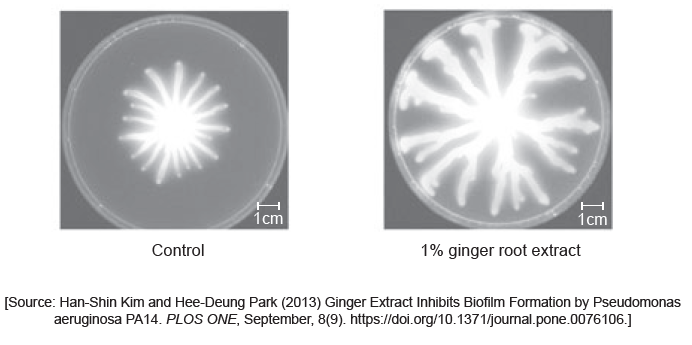
Evaluate the effect of 1 % ginger root extract on biofilm formation.
Outline the importance of avoiding biofilm formation in pipes carrying drinking water.
Answer/Explanation
Markscheme
a. bacteria spread out further with ginger/more than twice the distance with ginger/more spreading with ginger
b. more spreading means less biofilm formation
c. biofilms are usually made up of many species
OR
only tested the effect of ginger on one species
d. only tested over 24 hours
e. only tested with agar substrate/other substrates may have different effects
a. biofilms reduce flow rate in pipes
b. contamination of the drinking water supplies by biofilm microbes
c. biofilms may cause corrosion of pipes
Question
Cooperative aggregates of microorganisms can form biofilms. The micrograph shows a biofilm of Escherichia coli.
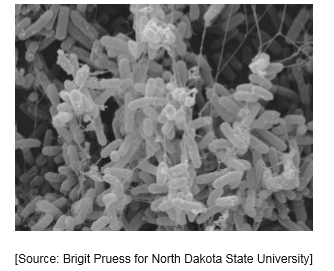
Outline the emergent properties of biofilms.
Explain two ways in which bacteria of the genus Pseudomonas can be used for bioremediation.
Answer/Explanation
Markscheme
a. the properties of the biofilm are greater than the sum of their individuals
b. the properties are not predictable from looking at the individual
c. quorum sensing
d. adhere to a variety of substances
e. resistant to antibiotics / antimicrobial
f. formation of EPS
Cooperative aggregates on its own is not accepted.
award [2 max]:
a. oil spills
b. oil is used as an organic source by the bacterium
OR
the bacterium changes the crude oil into less harmful substances
award [2 max]:
c. mercury from paint/fluorescent lights can leak into soil/water
OR
can form methyl mercury which travels along food chain/bioaccumulation
d. bacteria can remove methyl group from the methyl mercury/reduces toxicity
Allow other verified examples that include the danger to the environment (problem) and how the bacterium improves the situation (solution).
Question
Explain, with reference to one example, how a polluted ecosystem can be restored through bioremediation.
Answer/Explanation
Markscheme
Bioremediation is the use of microorganisms to metabolize toxins to remove them from the environment
Specific area or ecosystem affected by pollution
Name of pollutant
Source of pollutant
Identity of microorganism used
Manner in which microorganism makes use of pollutant
Supporting steps technicians have to undertake
Question
Many people around the world wash themselves under a warm shower. This personal hygiene may expose individuals to harmful microorganisms such as Mycobacterium avium through inhalation of water droplets from the shower head and direct water contact. Samples taken from biofilms inside shower heads and municipal water sources were analysed. Proportions of other non-tuberculous mycobacteria (NTM) were also analysed. The results are shown in the pie charts.
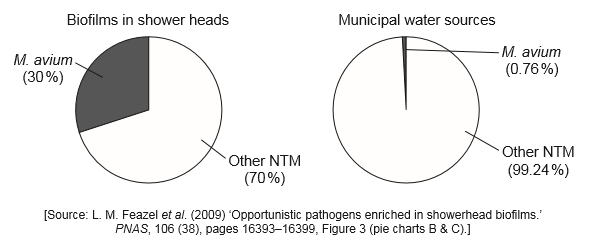
List two properties of biofilms.
Distinguish between the data for shower head biofilms and municipal water sources.
Suggest reasons for biofilms developing inside shower heads.
Answer/Explanation
Markscheme
They show emergent properties
They contain cooperative aggregates of microorganisms
The microorganisms cooperate through communication/quorum sensing
The microorganisms are highly resistant to antimicrobial agents
They adhere to a variety of surfaces
Formation/secretion of EPS/extracellular polymeric substances
Biofilms show a much higher percentage of M. avium than water
Accept inverse answer
Accept numerical answers
Conditions on the shower head favour bacterial growth
eg: moisture/temperature/nutrients
«Solid» surface on which to accumulate
Quorum reached
OR
critical concentration of signal molecules
Shower heads are seldom cleaned
Question
Vibrio cholerae live in aquatic environments and cause cholera. Some V. cholerae form aggregates that show characteristics not seen in individual bacteria. The bacteria in these aggregates monitor the population densities by quorum sensing. They produce quorum sensing proteins (QS + ). Some V. cholerae strains do not produce quorum sensing proteins (QS – ) and some only produce quorum sensing proteins in low amounts (QS c ).
V. cholerae strains isolated in China were examined. The pie charts show the percentage of different quorum-sensing systems in strains that contain cholera toxin genes and in strains that do not contain cholera toxin genes.
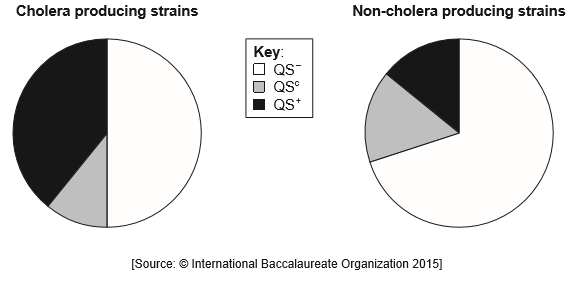
State the percentage of cholera producing strains that do not produce quorum sensing proteins (QS – ).
Determine the approximate percentage of non-cholera producing strains that produce quorum sensing proteins in low amounts (QSc ).
Compare the percentage of strains that do not produce quorum sensing proteins (QS – ) in strains with and without the cholera toxin genes.
Deduce, using the data, whether the genes for quorum sensing and for toxicity of cholera evolved together.
Vibrio cholerae is Gram-negative. Describe the structure of the cell wall of this bacterium.
Answer/Explanation
Markscheme
50 (%) (allow answers in the range of 48 (%) to 52 (%))
16 (%) (allow answers in the range of 12 (%) to 20 (%))
a. there are less QS− strains that produce cholera than those that do not produce cholera;
b. approximately 50 % in cholera producing and approximately 70 % in noncholera producing;
c. greatest percentage in QS− in both so most are not quorum sensing;
(the hypothesis is supported as)
a. more sensing in bacteria that cause cholera than in those that do not;
b. forming aggregates to facilitate the propagation of the pathogen / bacteria working together can produce pathogenicity;
c. bacteria with QS+ and cholera producing strains are positively selected;
a. thin layer of peptidoglycan sandwiched between outer and inner membrane layer;
b. outer layer containing lipopolysaccharide and (protein);
c. high lipid and low peptidoglycan content;
Accept correct answers on a clearly labelled diagram.
Question
Outline the role of saprotrophic bacteria in the treatment of sewage.
Explain the formation of methane from biomass.
Answer/Explanation
Markscheme
sewage trickled over bed of rocks with (biofilm of) saprotrophs and oxygen added;
saprotrophic bacteria feed on/break down organic matter (found in sewage);
transforming it into harmless/re-usable products/
, H2O, ammonia;
bioreactor with anaerobic conditions;
bacteria convert organic matter into organic acids/alcohol/acetate/ CO2 and H2;
methanogenic bacteria produce methane from breakdown of acetate/ CO2
and H2;
(Accept correct word or chemical equations)
Question
State two roles of microbes in ecosystems.
Answer/Explanation
Markscheme
producers
decomposers
nitrogen fixers
Two needed for one mark.
Question
The sludge produced in sewage treatment plants contains pathogenic microorganisms. In a study, sludge was heated to 80°C in order to kill the pathogens and the effectiveness of this treatment was compared using viruses (coliphages) and bacteria (Salmonella choleraesuis) which were added as indicators. The level of activity of either of these two indicators shows whether pathogenic microorganisms may have survived in the sewage sludge.
The resistance of the indicators to heat treatment was studied and their level of activity is shown in the following graph.
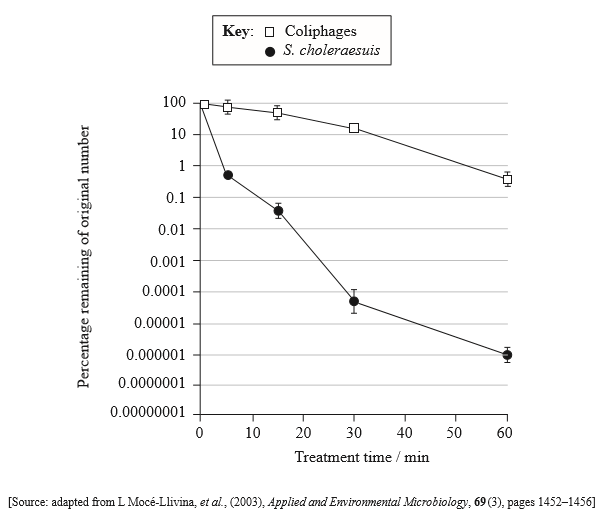
State which indicator was more resistant to the heat treatment.
Answer/Explanation
Markscheme
coliphages/viruses
Question
The sludge produced in sewage treatment plants contains pathogenic microorganisms. In a study, sludge was heated to 80°C in order to kill the pathogens and the effectiveness of this treatment was compared using viruses (coliphages) and bacteria (Salmonella choleraesuis) which were added as indicators. The level of activity of either of these two indicators shows whether pathogenic microorganisms may have survived in the sewage sludge.
The resistance of the indicators to heat treatment was studied and their level of activity is shown in the following graph.
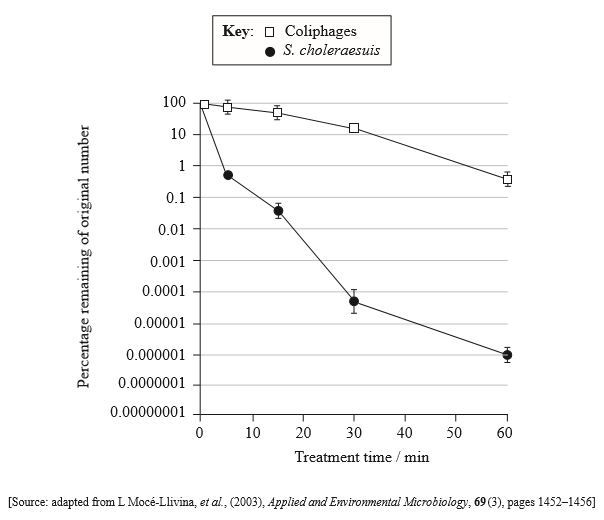
Compare the effect of the 80°C heat treatment on coliphages and S. choleraesuis.
Discuss whether the heat treatment should be continued beyond 60 minutes if this technique were to be used in sewage treatment plants.
In many areas, sewage is discharged directly into the environment. State two potential environmental consequences of releasing sewage into rivers.
Answer/Explanation
Markscheme
number of both types (bacteria and viruses) is reduced;
the reduction of bacteria was greater than for viruses;
in the first 10 minutes reduction of bacteria is large whereas reduction of viruses is gradual;
after 30 minutes less than 0.0001 % of bacteria remain while about 10 % of viruses remain; Accept any other reasonable comparison.
not necessary for bacteria as nearly all have been killed;
necessary for coliphages as they take longer to denature/destroy/are still present;
depends whether pathogens in sewage are heat tolerant;
depends on the cost of the treatment;
depends whether presence of a few microbes in treated sewage is harmful;
anaerobic conditions / increases BOD (biological oxygen demand) / eutrophication;
low dissolved oxygen may kill (aerobic) organisms;
pathogens/cause health hazards (bathing or drinking water);
algal blooms;
diversity falls/favours organisms able to survive low oxygen levels;
Question
Outline the role of saprotrophic bacteria in the treatment of sewage.
Answer/Explanation
Markscheme
saprotrophs/decomposers feed on/break down organic material;
requires high oxygen/aerobic environment;
nitrifying bacteria convert ammonia to nitrates;
trickle filter bed/reed bed systems optimize environment for saprotrophs;
Question
Explain the consequences of releasing raw sewage into rivers and the involvement of microorganisms in this process.
Answer/Explanation
Markscheme
a. eutrophication;
b. algal bloom deprives other organisms of light;
c. death of organisms;
d. microorganisms/decomposers increase oxygen demand/BOD;
e. causing deoxygenation of river;
f. formation of hydrogen sulphide/ammonia/nitrites;
g. which are toxic to some organisms;
h. pathogenic organisms released into water;
